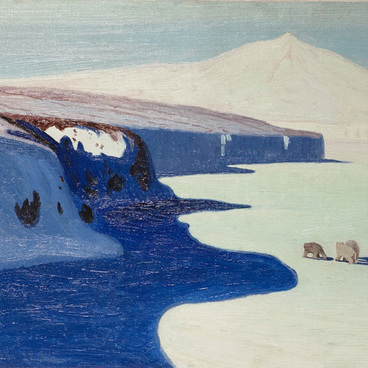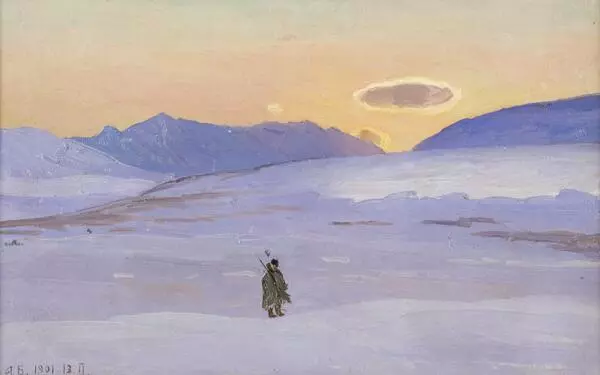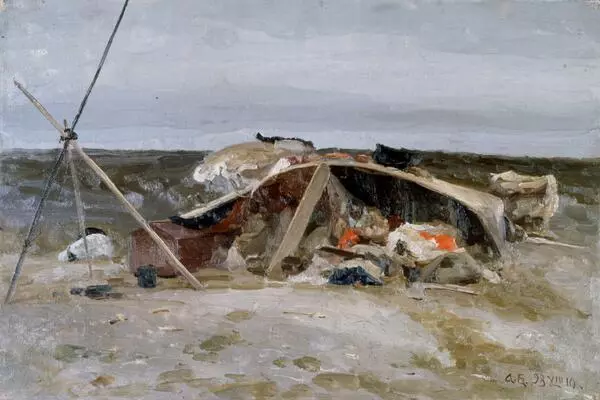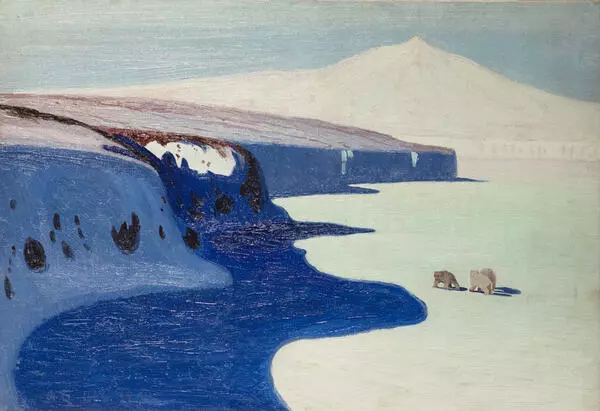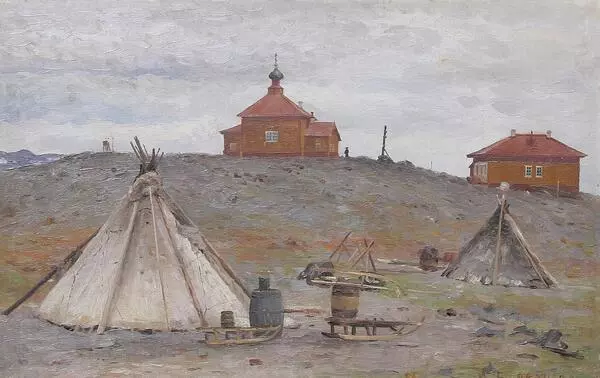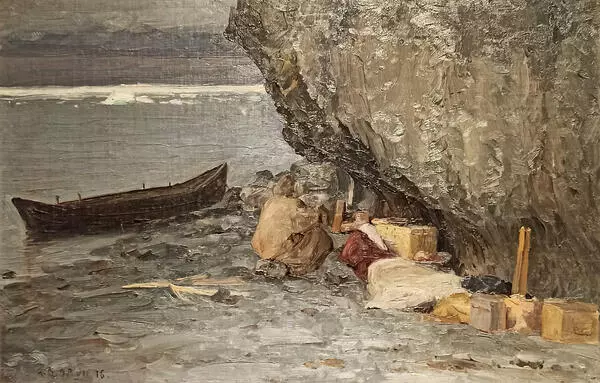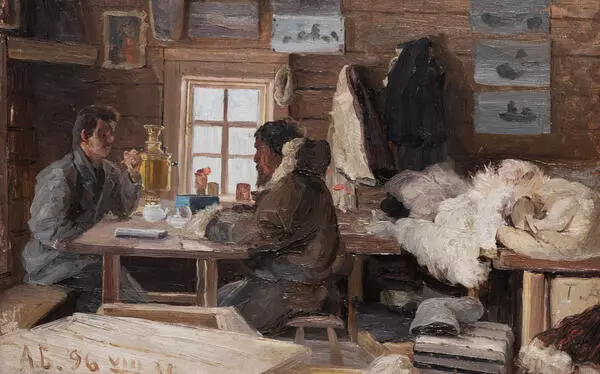The is a Nenets riddle: it walks in the tundra on four legs and lies as a hillock in the chum. The answer is ‘dog’. In this picture, Alexander Borisov depicted the ‘lying’ version of the dogs, although, instead of lying in a chum, they lie on a sled.
In his travels, not only he learned how to drive a reindeer team, but also was able to navigate a dog sled, although dog teams were not widely used among the Nenets people. The artist wrote about this experience in his diary: ‘Dog-sledging is quite hard and unpleasant. When going downhill, they rush forward like crazy, doing their best to collide with a stone or a rock and break the sled. The wagon will tip over, and the sled will smash into pieces. At that point, the dogs stop and stand still, watching and licking their lips, their faces sly as if they were laughing at their master.’
In his book Visiting the Samoyed People, Alexander Borisov told a lot of interesting stories. ‘If I went somewhere on skis, I always brought along a dog, a Samoyed laika that I had bought in Ust-Tsilma. Once I dropped in on my neighbour Samoyeds, and they told me sincerely: “When you appeared from behind the hills, the old woman told us: look, there is a man walking, he is walking in the tundra, he must be a bad man, we should kill him. We even took a rifle to shoot you, but then we saw the dog. Ah, he is with a dog! Then, he must be a good man!”
Dogs are an important part of the Samoyed culture. There is a hypothesis that the Northern people domesticated the white wolf many years ago, and this way the “Samoyed dog” breed appeared. Dogs were used for deer herding, hunting, transportation, and, sometimes, as baby nurses. They often stay in the chum through the night: people cuddle with them to keep themselves warm. If you hug a Samoyed dog, it becomes very still and attentive, so as not to disturb the human.
However, the Samoyed dogs were not harnessed to the sled. That’s why the dog depicted here is not a Samoyed: it is obvious, because it has black patches. Most likely, it’s a mixed breed of Samoyed and Nenets laika, because the Nenets laikas neither were harnessed to the sled. The Nenets believed that there are dogs apt for different jobs, so they had many groups of dogs for different tasks: gathering the herd, guiding the cattle home, looking for lost deer, keeping the herd together.
In his travels, not only he learned how to drive a reindeer team, but also was able to navigate a dog sled, although dog teams were not widely used among the Nenets people. The artist wrote about this experience in his diary: ‘Dog-sledging is quite hard and unpleasant. When going downhill, they rush forward like crazy, doing their best to collide with a stone or a rock and break the sled. The wagon will tip over, and the sled will smash into pieces. At that point, the dogs stop and stand still, watching and licking their lips, their faces sly as if they were laughing at their master.’
In his book Visiting the Samoyed People, Alexander Borisov told a lot of interesting stories. ‘If I went somewhere on skis, I always brought along a dog, a Samoyed laika that I had bought in Ust-Tsilma. Once I dropped in on my neighbour Samoyeds, and they told me sincerely: “When you appeared from behind the hills, the old woman told us: look, there is a man walking, he is walking in the tundra, he must be a bad man, we should kill him. We even took a rifle to shoot you, but then we saw the dog. Ah, he is with a dog! Then, he must be a good man!”
Dogs are an important part of the Samoyed culture. There is a hypothesis that the Northern people domesticated the white wolf many years ago, and this way the “Samoyed dog” breed appeared. Dogs were used for deer herding, hunting, transportation, and, sometimes, as baby nurses. They often stay in the chum through the night: people cuddle with them to keep themselves warm. If you hug a Samoyed dog, it becomes very still and attentive, so as not to disturb the human.
However, the Samoyed dogs were not harnessed to the sled. That’s why the dog depicted here is not a Samoyed: it is obvious, because it has black patches. Most likely, it’s a mixed breed of Samoyed and Nenets laika, because the Nenets laikas neither were harnessed to the sled. The Nenets believed that there are dogs apt for different jobs, so they had many groups of dogs for different tasks: gathering the herd, guiding the cattle home, looking for lost deer, keeping the herd together.


